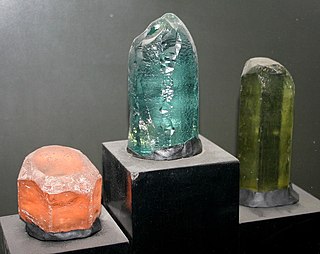
Beryl ( BERR-əl) is a mineral composed of beryllium aluminium silicate with the chemical formula Be3Al2Si6O18. Well-known varieties of beryl include emerald and aquamarine. Naturally occurring, hexagonal crystals of beryl can be up to several meters in size, but terminated crystals are relatively rare. Pure beryl is colorless, but it is frequently tinted by impurities; possible colors are green, blue, yellow, pink, and red (the rarest). It is an ore source of beryllium.
In geology, felsic is a modifier describing igneous rocks that are relatively rich in elements that form feldspar and quartz. It is contrasted with mafic rocks, which are relatively richer in magnesium and iron. Felsic refers to silicate minerals, magma, and rocks which are enriched in the lighter elements such as silicon, oxygen, aluminium, sodium, and potassium. Felsic magma or lava is higher in viscosity than mafic magma/lava.

Marble is a metamorphic rock consisting of carbonate minerals that recrystallize under the influence of heat, pressure and aqueous solutions, most commonly calcite (CaCO3) or dolomite and has a crystalline texture of varying thickness. Marble is typically not foliated (layered), although there are exceptions.

Topaz is a silicate mineral of aluminium and fluorine with the chemical formula Al2SiO4(F,OH)2. It is used as a gemstone in jewelry and other adornments. Common topaz in its natural state is colorless, though trace element impurities can make it pale blue or golden brown to yellow orange. Topaz is often treated with heat or radiation to make it a deep blue, reddish-orange, pale green, pink, or purple.

Flint, occasionally flintstone, is a sedimentary cryptocrystalline form of the mineral quartz, categorized as the variety of chert that occurs in chalk or marly limestone. Flint was widely used historically to make stone tools and start fires.
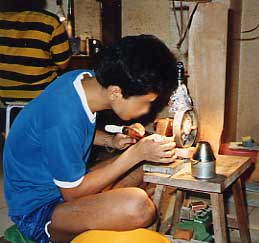
Lapidary is the practice of shaping stone, minerals, or gemstones into decorative items such as cabochons, engraved gems, and faceted designs. A person who practices lapidary is known as a lapidarist. A lapidarist uses the lapidary techniques of cutting, grinding, and polishing. Hardstone carving requires specialized carving techniques.

Jasper, an aggregate of microgranular quartz and/or cryptocrystalline chalcedony and other mineral phases, is an opaque, impure variety of silica, usually red, yellow, brown or green in color; and rarely blue. The common red color is due to iron(III) inclusions. Jasper breaks with a smooth surface and is used for ornamentation or as a gemstone. It can be highly polished and is used for items such as vases, seals, and snuff boxes. The specific gravity of jasper is typically 2.5 to 2.9. Jaspillite is a banded-iron-formation rock that often has distinctive bands of jasper.

In archaeology, a hammerstone is a hard cobble used to strike off lithic flakes from a lump of tool stone during the process of lithic reduction. The hammerstone is a rather universal stone tool which appeared early in most regions of the world including Europe, India and North America. This technology was of major importance to prehistoric cultures before the age of metalworking.

Lasagna is a type of pasta, possibly one of the oldest types, made of very wide, flat sheets. Either term can also refer to an Italian dish made of stacked layers of lasagna alternating with fillings such as ragù, béchamel sauce, vegetables, cheeses, and seasonings and spices. The dish may be topped with grated cheese, which becomes melted during baking. Typically cooked pasta is assembled with the other ingredients and then baked in an oven. The resulting baked pasta is cut into single-serving square or rectangular portions.
In archaeology, lithic analysis is the analysis of stone tools and other chipped stone artifacts using basic scientific techniques. At its most basic level, lithic analyses involve an analysis of the artifact's Morphology (archaeology), the measurement of various physical attributes, and examining other visible features.
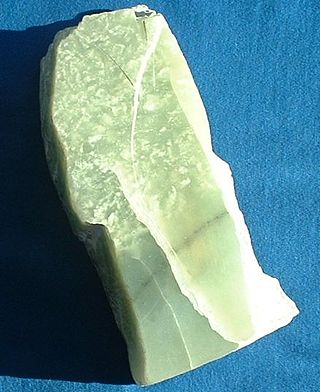
Jade is a mineral used as jewellery or for ornaments. It is typically green, although may be yellow or white. Jade can refer to either of two different silicate minerals: nephrite, or jadeite.

In geology, rock is any naturally occurring solid mass or aggregate of minerals or mineraloid matter. It is categorized by the minerals included, its chemical composition, and the way in which it is formed. Rocks form the Earth's outer solid layer, the crust, and most of its interior, except for the liquid outer core and pockets of magma in the asthenosphere. The study of rocks involves multiple subdisciplines of geology, including petrology and mineralogy. It may be limited to rocks found on Earth, or it may include planetary geology that studies the rocks of other celestial objects.
The long hundred, also known as the great hundred or twelfty, is the number 120 that was referred to as hund,hund-teontig,hundrað, hundrath, or hundred in Germanic languages prior to the 15th century, and is now known as one hundred twenty, or six score. The number was translated into Latin in Germanic-speaking countries as centum, but the qualifier long is now added because English now uses hundred exclusively to refer to the number of five score (100) instead.
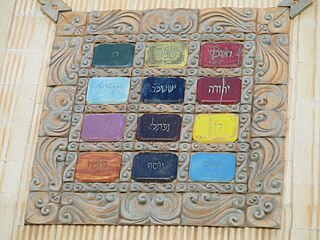
The priestly breastplate or breastpiece of judgment was a sacred breastplate worn by the High Priest of the Israelites, according to the Book of Exodus. In the biblical account, the breastplate is termed the breastplate of judgment, because the Urim and Thummim were placed upon it.(Exodus 28:30). These elements of the breastplate are said in the Exodus verse to carry the judgement of God concerning the Israelites at all times.

Chrysoprase, chrysophrase or chrysoprasus is a gemstone variety of chalcedony that contains small quantities of nickel. Its color is normally apple-green, but varies to deep green. The darker varieties of chrysoprase are also referred to as prase.

Ashlar is finely dressed stone, either an individual stone that has been worked until squared, or a structure built from such stones. Ashlar is the finest stone masonry unit, generally rectangular cuboid, mentioned by Vitruvius as opus isodomum, or less frequently trapezoidal. Precisely cut "on all faces adjacent to those of other stones", ashlar is capable of very thin joints between blocks, and the visible face of the stone may be quarry-faced or feature a variety of treatments: tooled, smoothly polished or rendered with another material for decorative effect.

In ancient Rome, the Latin word pagus was an administrative term designating a rural subdivision of a tribal territory, which included individual farms, villages, and strongholds serving as refuges, as well as an early medieval geographical term. From the reign of Diocletian onwards, the pagus referred to the smallest administrative unit of a province. These geographical units were used to describe territories in the Merovingian and Carolingian periods, without any political or administrative meaning.
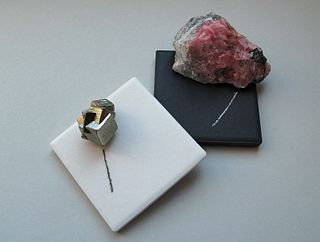
The streak of a mineral is the color of the powder produced when it is dragged across an un-weathered surface. Unlike the apparent color of a mineral, which for most minerals can vary considerably, the trail of finely ground powder generally has a more consistent characteristic color, and is thus an important diagnostic tool in mineral identification. If no streak seems to be made, the mineral's streak is said to be white or colorless. Streak is particularly important as a diagnostic for opaque and colored materials. It is less useful for silicate minerals, most of which have a white streak or are too hard to powder easily.
The Silex Piano is a musical instrument of the Lithophone family. It was created by Honoré Baudre, circa 1885 and was described in several contemporary publications.

The Neolithic flint mines of Spiennes are among the largest and earliest Neolithic flint mines which survive in north-western Europe, located close to the Walloon village of Spiennes, southeast of Mons, Belgium. The mines were active during the mid and late Neolithic between 4,300 and 2,200 BC. Declared to be "remarkable for the diversity of technological solutions used for extraction" the site and its surroundings were inducted into the UNESCO's list of World Heritage Sites in 2000.















